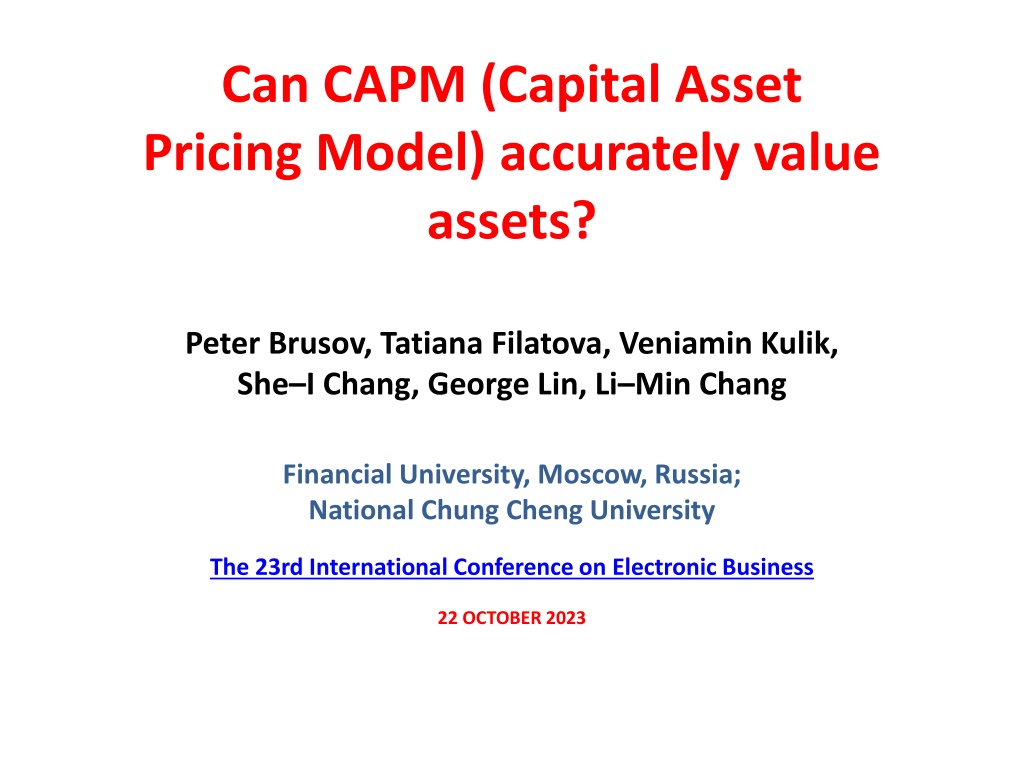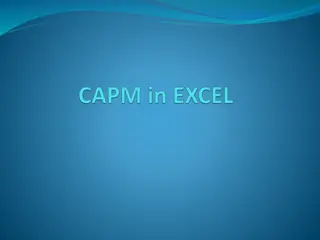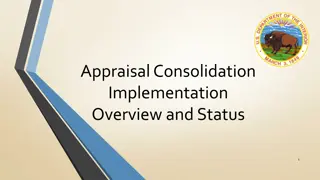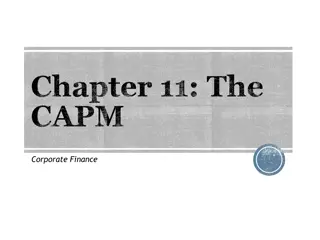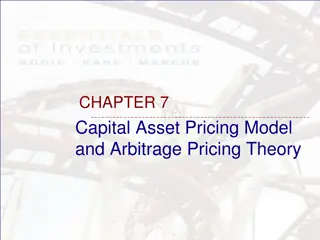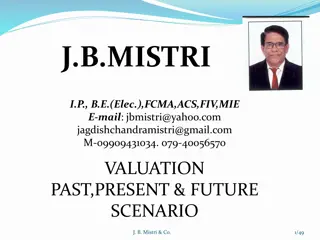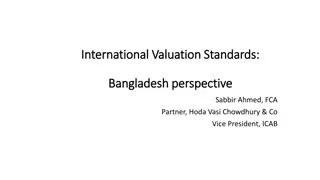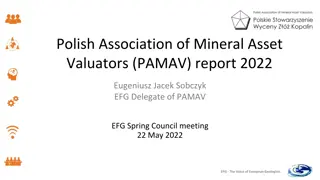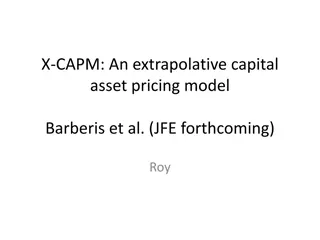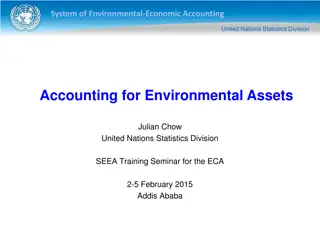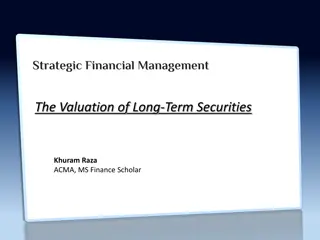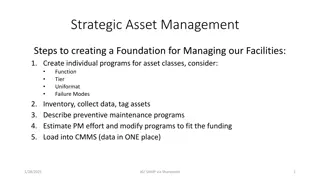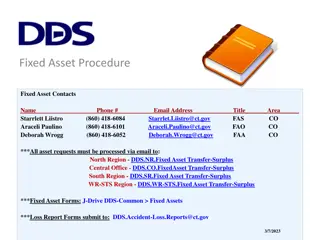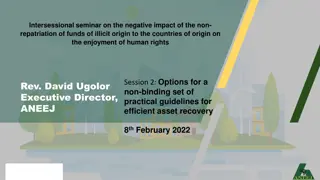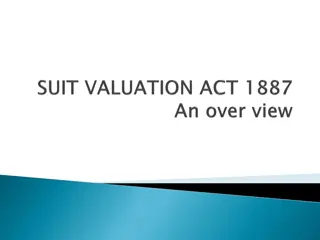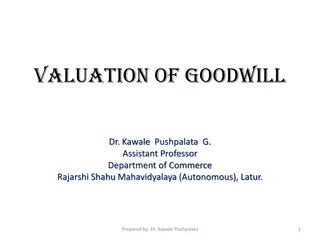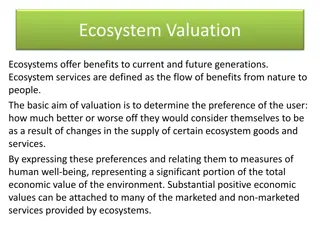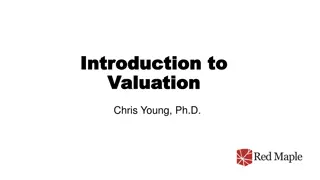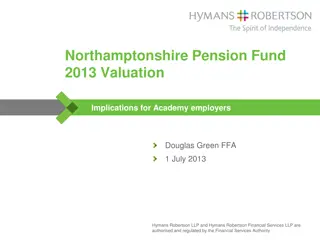Challenges in Asset Valuation Using CAPM
Analysis of the Capital Asset Pricing Model (CAPM) for listed companies demonstrates significant discrepancies between the model's results and actual returns. Various factors contributing to this deviation are discussed, including the limitations of the model and potential modifications to enhance its accuracy and applicability. The fundamental properties of CAPM, assumptions, and formulas are explored, shedding light on its simplistic yet widely utilized approach in assessing asset profitability.
Download Presentation

Please find below an Image/Link to download the presentation.
The content on the website is provided AS IS for your information and personal use only. It may not be sold, licensed, or shared on other websites without obtaining consent from the author. Download presentation by click this link. If you encounter any issues during the download, it is possible that the publisher has removed the file from their server.
E N D
Presentation Transcript
Can CAPM (Capital Asset Pricing Model) accurately value assets? Peter Brusov, Tatiana Filatova, Veniamin Kulik, She I Chang, George Lin, Li Min Chang Financial University, Moscow, Russia; National Chung Cheng University The 23rd International Conference on Electronic Business 22 OCTOBER 2023
Our analysis within CAPM for several dozen listed companies from different countries, as well as numerous results of other authors, showed that the CAPM results differ significantly from the real returns of companies. The reasons for this discrepancy are discussed, which are related to the internal properties and shortcomings of the model, as well as its possible modifications that can bring the model closer to real life. Among the latter, accounting for financial risk in CAPM along with business risk, various amendments such as the Fama-French corrections, Arbitrage Pricing Theory (APT) and the incorporation of CAPM into modern capital structure theories.
CAPM (CAPITAL ASSET PRICING MODEL) PROPERTIES CAPM is a simple, but widely used, one factor model that describes the relationship between the expected return on assets (stocks, investments, etc.) and the risk free rate, taking into account systematic (business) risk. This relationship is described by the equity risk premium, which depends on the asset's beta (which describes the asset's correlation or sensitivity to the market), the risk free rate (say, the Treasury bill rate or the central bank's key rate), and the expected return in the market. CAPM assumes an idealized open market structure where all risky assets refer to all tradable shares available to everyone. In addition, we have a risk-free asset (for borrowing and/or lending in unlimited quantities) with an interest rate of kf. One assumes that all information is available to everyone, such as covariances, variances, average stock returns and so on. It is also assumed that the investor is a rational, risk-averse, who uses the same Markowitz portfolio theory.
The assumptions are made within the CAPM model . The following assumptions are made within the CAPM model: All investors are risk averse and have the same time frame to evaluate information. Unlimited capital exists to borrow at the risk free rate. Investments can be divided into unlimited parts and sizes. Taxes, inflation and transaction costs are absent. Return and risk are linearly related. CAPM (Capital Asset Pricing Model) describes the profitability of asset and is described by the following formula: Here kf is risk free profitability, b b is the coefficient of the company. k k + = b ( ) k k i f i m f
The coefficient shows the dependence of the return on the asset and the return on the market as a whole. The coefficient is described by the following formula . s cov b = = im 2 i i im s s m m Here s si is the risk (standard deviation) of i th asset, s sm is market risk (standard deviation of market index), cov im is covariance between i th asset and market portfolio.
The betacoefficient of a security, b b, has the meaning of the amount of riskiness of this security. It follows from formula that: 1) if b b=1 the yield of the security is equal to the yield of the average market portfolio (ki = kf ); 2) if b b > 1, the security is more risky than the average on the security market (ki > kf ); 3) if b b <1, the security is less risky than the average on the security market (ki < kf ).
Disadvantages of the CAPM model. 1.The CAPM formula only works under assumption that the market is dominated by purely rational players who make decisions that favor only investment returns. This, of course, is not always true. 2. CAPM assumes that each market participant acts on the basis of the same information. In reality, relevant information is distributed unevenly among the public, so some participants may make decisions based on information that others do not. 3. Using beta as the main part of the formula. But beta takes into account only changes in the stock price in the market. However the share price can change for reasons other than the market. Stocks can rise or fall in value for deliberate reasons, not just volatility. 4. CAPM only uses historical data. But historical stock price changes are not enough to determine the overall risk of an investment. Other factors should be considered, such as economic conditions, industry peculiarities and competitor characteristics, and internal and external activities of the company itself. So, the model has a number of limitations: the model does not take into account taxes, transaction costs, non transparency of the financial market, etc. Finally, to predict future returns, a retrospective level of market risk is used, which leads to a forecast error.
MODIFICATIONS OF THE CAPITAL ASSET PRICING MODEL (CAPM) The CAPM approach is still evolving and we will describe some of the directions of this development below. 1.The distribution function: The symmetric CAPM One of the remaining internal problems of CAPM is the distribution function. The Capital Asset Pricing Model (CAPM) assumes a Gaussian or Normal distribution. In practice, this assumption may be violated. In paper (Leal D. et al. 2023) a symmetric CAPM is proposed, assuming distributions with lighter or heavier tails than the normal distribution. Elliptic distributions (normal, exponential and Student t) are considered.
2.The multiple factors models The CAPM operates on only one factor that affects the future performance of a stock. There are several models with multiple factors that modify the CAPM in this regard. Among them are Fama-French (three- and five- factor models) and APT (Arbitrage Pricing Theory) models . Fama-French model In 1992, Y. Fama and K. French (Fama and French, 1992) proved that future returns are also affected by factors such as company size and industry affiliation. They have developed three- and five- factor models.
FamaFrench Threefactor Model Fama French three factor model takes into account two additional risk factors, namely, size and book to market equity along with market beta ( k k k k f m U f e + = b ) + + s SMB h HML were SMB the difference between the returns of companies with large and small capitalization; HML the difference between the returns of companies with low and high intrinsic value (indicator B/P).
FamaFrench Fivefactor Model The equation of Fama French five factor model (Fama and French, 1993, 1995) in addition to the difference between the returns of companies with large and small capitalization(SMB) and the difference between the returns of companies with low and high intrinsic value (indicator B/P)(HML) accounts return on equity and company capital expenditure and has a view ( SMB s k k k f m U f e + + = b ) + + + k h HML r RMW c CMA where RMW return on equity; CMA company capital expenditure.
Arbitrage Pricing Theory (APT) In the Arbitrage Pricing Theory (APT model), the return on an asset can be expressed by the following formula: F F a r b b + + = 2 1 1 , + + b + ... F 2 i i i i in n i where ai is a constant per asset; Fi is a systematic factor, such as a macroeconomic or company-specific factor; i is the sensitivity of the asset in relation to the factor Fi; and i is a random variable with an expected mean of zero. In opposite to the CAPM, which has only one factor and one beta, the APT formula has multiple factors that include non-company factors, which requires the asset's beta with respect to each separate factor. The APT does not explain what these factors are, and APT model users should analytically determine factors that might affect the asset's returns.
3. ACCOUNT OF BUSINESS AND FINANCIAL RISKS Two models - Hamada model, by R. Hamada (1961) and CAPM 2.0 model, by Brusov Filatova Kulik (2023) account the business and financial risks. The first author did this phenomenologically, and the second authors - analytically. Hamada Model The Modigliani Miller theory with taxes (Modigliani and Miller, 1963) has been united with CAPM (Capital asset pricing model) in 1961 by R. Hamada. For the cost of equity of a leveraged company, the below formula has been derived.
( ) ( ) D ( ) t = + b + b 1 k k k k k k e f U m f U m f S The first term represents risk free profitability kf, the second term is business risk premium, , and the third term is financial risk premium . In the case of an unlevered company (D = 0), the financial risk (the third term) is zero, and its shareholders receive only a business risk premium. Hamada used an empirical approach in incorporating the level of leverage into the CAPM. One of the main objectives in his research was to distinguish companies without leverage from companies with leverage. The latter make up almost the majority of real companies. In 1972, he surveyed 304 companies, among which he found 102 non leveraged and 202 leveraged (Hamada 1972). Comparing equity returns of two types of companies, he got his formula for the b b factor, which takes into account the level of leverage.
CAPITAL ASSET PRICING MODEL 2.0 (CAPM 2.0) The approach CAPM 2.0. (Brusov Filatova Kulik 2023), in opposed to conventional CAPM, which accounts only business risk, correctly accounts both business and financial risks. Substituting the CAPM formula k k + = b 0 ( ) k k f U m f into Modigliani Miller formula for equity cost ( k L k k e 0 0 )( ) t = + 1 k d one gets the following result ) k t m U + b ( ) ( ( ) ( ( ) ) ( ) t = + + 1 1 1 1 1 k k L k L t Lk e f f d
The second term is the same as in Hamada's formula, but the first term is renormalized value of risk free profitability and the last term, which depends on the cost of debt kd, is missing from Hamada's formula. So the difference with Hamada's formula is: while in Hamada's formula only beta coefficient is renormalized, in formula CAPM 2.0 the first term (risk free return) is also renormalized by the same factor and the last term, depending on the cost of debt kd, appears, which is absent in Hamada's formula. Factor (tax corrector) exists due to the tax shield. ( )( t L = 1 . ) k k f d This is the difference CAPM 2.0 formula from Hamada's one.
ikikik Comparison of Walt Disney Company: DIS shares profitability estimates for the period 2018 2022 on CAPM and on the new CAPM 2.0 approach Year 2018 2019 2020 2021 2022 kf 3. 02 % 2.39 % 1.646% 1. 91 % 3.98 % 0.08% 0.11 % 0.64% 0.45% 0.31% ki, Company 14.51% 43.91% 1.99% 31.90% 25.27% ki, Industry 29.94% 1.78% 18.94% 34.55% 2.96% ki, Market 23.64% 2.28% 27.13% 24.14% 32.61% 29.63% CAPM 2.0 (Industry) 1.70% 18.83% 33.91% 2.51% 23.33% CAPM 2.0 (market) 2.36% 27.02% 23.50% 32.16%
ikikik Comparison of PJSC Rosneft, ROSN profitability estimates for the period 2018 2021 on CAPM and on the new CAPM 2.0 approach Year 2018 2019 2020 2021 kf 8.02% 7.59% 6.27% 7.34% 26.40% 23.69% 14.44% 19.20% Company ki, % 53.3% 7.2% 4.4% 42.0% CAPM ki, Industry % 27.4% 21.4% 20.3% 24.1% CAPM ki, Market % 9.93% 24.96% 8.66% 15.05% CAPM 2.0 (Industry) 53.8% 45.09% 5.86% 43.3% CAPM 2.0 (market) New approach 36.33% 48.65% 23.10% 34.25%
When kd exceeds kf, the financial risk premium becomes negative. As well for companies from the extractive industries, such as Rosneft etc, whose leverage level, due to the specifics of the industry is quite high, the premium for financial risk is high as well. At the same time, companies with a typical level of leverage from 0.5 to 1 (1.5) have a low financial risk premium compared to a business risk . This is well seen for Walt Disney Company (L is of order 0.5) and for Pfizer INC. (L is of order 1 1.5).
The value added to the company's return ( ) within CAPM 2.0 model with respect to results of conventional CAPM does not depend on the industry or market version of CAPM and turns out to be the same for both cases. The results obtained show that accounting for financial risk properly significantly affects the assessment of the return on assets. The proposed approach allows making forecasts on the company's profitability without using the theory of capital structure. Estimated financial risk premiums depend on the level of leverage (capital structure) and the cost of borrowings. By planning the values of these parameters, the manager can predict the profitability of the company in the future. The novelty of the CAPM 2.0 model lies in the development of a new approach that generalizes CAPM to account for both business and financial risks.
The classic version of CAPM, although it seems reasonable, is far from reality. Numerous modifications, including CAPM 2.0 can make CAPM more applicable to real companies and investments Thank you for your attention!
